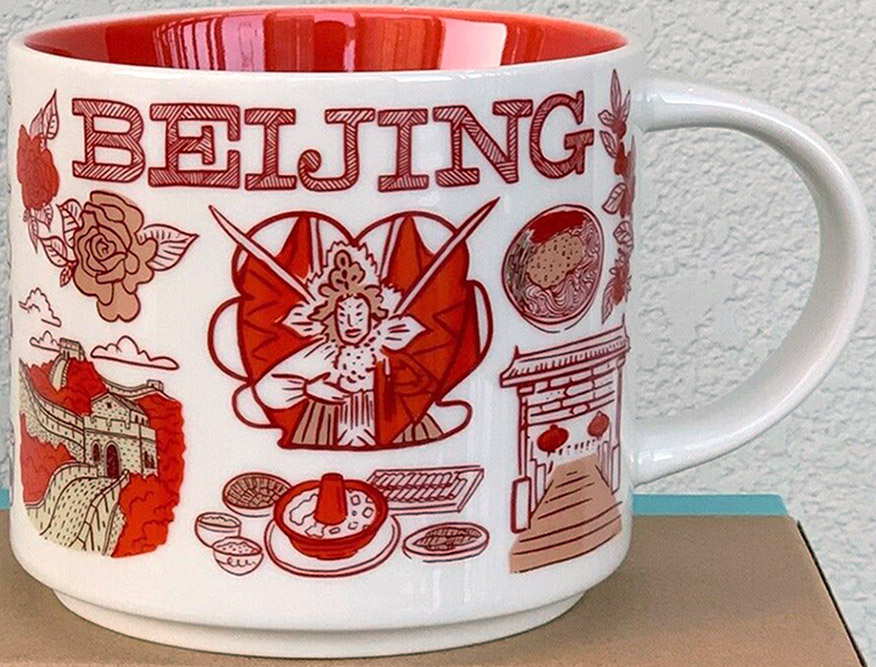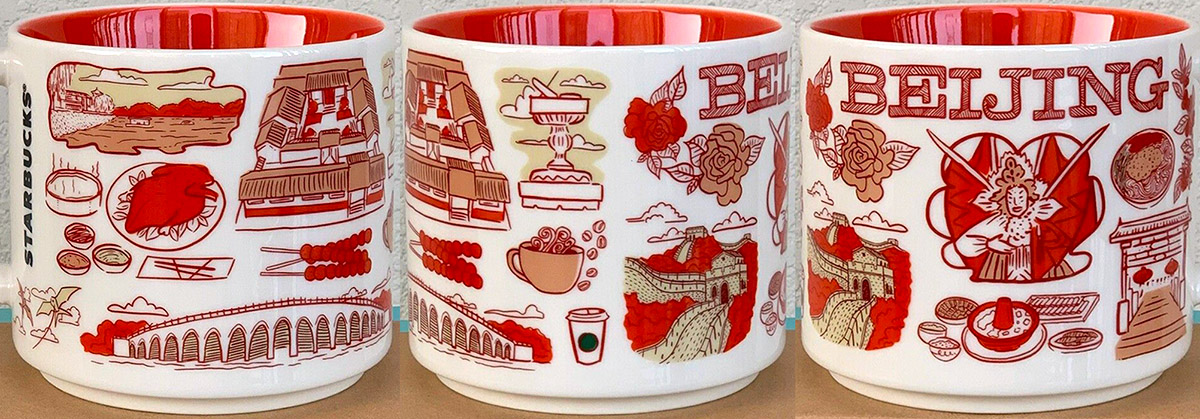
Been There – Beijing
Starbucks Been There – Beijing is a mug for the capital of the People’s Republic of China and one of the world’s largest cities, encompassing an area of approximately 6,500 square miles. With a population exceeding 21 million people, it stands as China’s second-most populous city, serving as a bustling hub of culture, politics, and innovation.
Beijing boasts a rich history dating back over three millennia. Originally known as Ji, it became a prominent city during the Zhou Dynasty (1046–256 BCE). Later, as the political and cultural center of China, it was named Yanjing during the Liao Dynasty (907–1125) and Zhongdu during the Jin Dynasty (1115–1234). The city assumed its current name, Beijing, meaning “Northern Capital,” in 1403 during the Ming Dynasty (1368–1644) when Emperor Yongle moved the capital there. Throughout its history, Beijing has endured numerous dynastic changes, invasions, and modernizations, evolving into the vibrant metropolis it is today, blending ancient traditions with modern innovations.
Here are some of the landmarks of Shanghai that we can see in the design of the mug:
– Badaling is a section of the Great Wall of China located in Yanqing County, approximately 45 miles north of downtown Beijing. It is the most visited section of the Great Wall which is known for its accessibility and historical significance. It has been open to tourists since 1957. Visitors can enjoy breathtaking views, hike along the wall, or take a cable car to explore different sections. It is important to plan ahead, purchase tickets in advance, and come prepared for the weather conditions.
And to add a couple more words about the Great Wall of China itself. It is an iconic landmark that stretches across northern China, spanning approximately 13000 miles, and is a testament to the ingenuity and determination of ancient Chinese civilizations. Originally built as a defensive structure, the Great Wall consists of various sections, each with its own unique features and historical significance. Today, it stands as a symbol of China’s rich history. It attracts millions of visitors from around the world who come to marvel at its grandeur and explore its remarkable architecture.
– Located in the heart of Beijing, the Forbidden City was the imperial palace for centuries, housing emperors and their dynasties. Its vast complex of courtyards, palaces, and gardens offers a glimpse into the opulent lives of China’s rulers. Visitors can explore its many halls and museums, admiring the intricate architecture and learning about China’s imperial past.
– The Chinese Rose, also known as the Rosa Chinensis, traces back over a thousand years to ancient China. Believed to have originated in the Middle Kingdom, this iconic flower holds deep cultural significance in Chinese tradition.
Roses hold a symbolic connection to Beijing through the city’s renowned Rose Festival, which celebrates the beauty and cultural significance of this iconic flower. Each year, usually in late spring or early summer, Beijing hosts this vibrant festival, showcasing a dazzling array of rose varieties in full bloom. The event attracts locals and tourists alike, offering a picturesque backdrop for strolls and cultural performances amidst fragrant rose gardens.
– Located on the outskirts of Beijing, the Summer Palace is a sprawling imperial garden known for its picturesque landscapes and exquisite architecture. Emperors and their families used it as a summer retreat, escaping the heat of the city. Visitors can enjoy boat rides on Kunming Lake, explore the Long Corridor with its painted scenes, and admire the beauty of the Marble Boat.
– During the Spring Festival, which typically lasts from the last lunar December to lunar January 15, Beijing is immersed in a festive atmosphere. Themed events and celebrations take place throughout the city, including shopping, ice and snow activities, internet-popular attractions, and Lantern Festival celebrations. Visitors can enjoy the decorations, entertainment performances, and traditional crafts such as kite making, paper cutting, and shadow play painting. Beijing’s temple fairs are also a highlight during the Spring Festival, offering a chance to experience traditional customs, watch performances, and sample local snacks
– Lugou Bridge, also known as the Marco Polo Bridge, is an architecturally significant structure of the city. It is an eleven-arch granite bridge that was first erected under the Jin dynasty and later restored during the reign of the Kangxi Emperor of the Qing dynasty in 1698. The bridge gained its Western name from its appearance in Marco Polo’s Book of Travels, where he praised it highly.

















































































